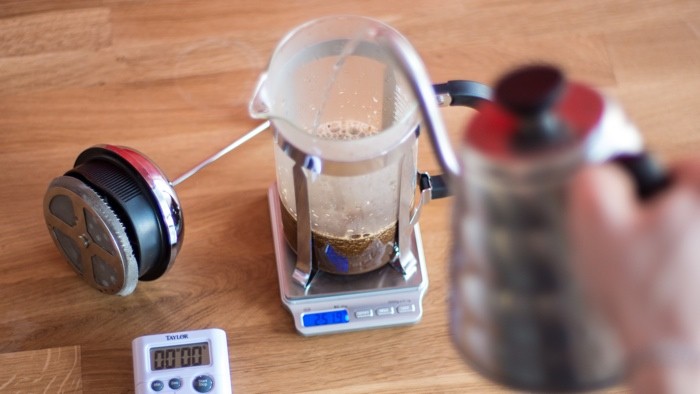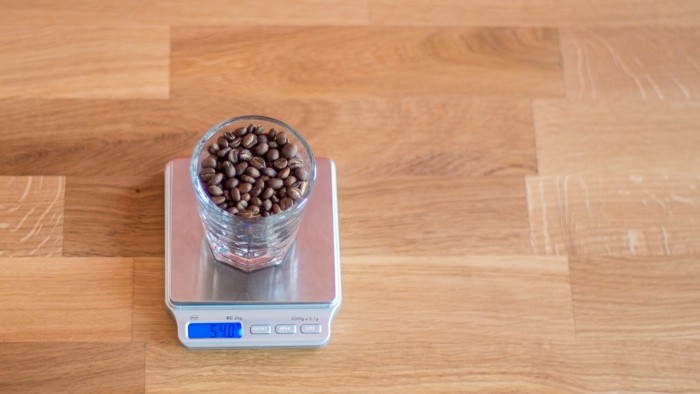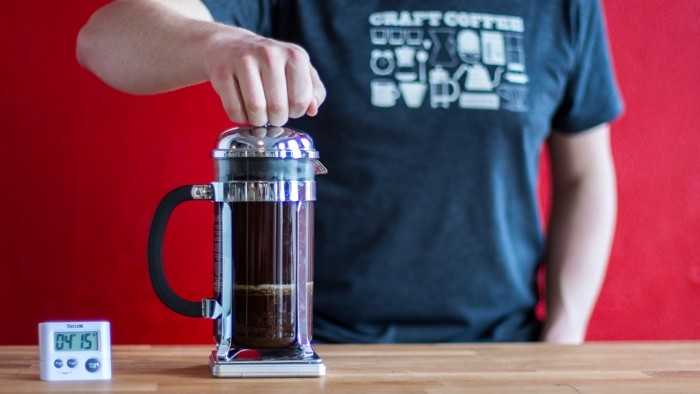Brewing the perfect cup of coffee with a French press can be an art. It requires precision, patience, and understanding the right coffee-to-water ratio. This guide from HOW.EDU.VN will provide a comprehensive overview of how much coffee you need for a coffee press, ensuring a delightful and satisfying brew every time. Discover expert tips and tricks to achieve optimal flavor extraction and unlock the full potential of your French press, including adjusting the coffee dose and grind size.
1. Understanding the Basics of French Press Coffee
Before diving into the specifics of coffee-to-water ratios, it’s essential to understand the fundamental principles of French press brewing. This brewing method, also known as a plunger pot or cafetière, involves steeping coffee grounds directly in hot water, allowing for a full-bodied and sediment-rich cup of coffee. The French press is renowned for its simplicity and ability to extract the coffee’s natural oils and flavors, resulting in a unique and robust taste profile.
1.1. The Importance of the Coffee-to-Water Ratio
The coffee-to-water ratio is a critical factor in determining the strength and flavor of your French press coffee. Using too little coffee can result in a weak and watery brew, while using too much coffee can lead to an overly bitter and muddy cup. Achieving the perfect balance requires careful measurement and consideration of personal preferences.
1.2. Key Factors Affecting the Ideal Ratio
Several factors can influence the ideal coffee-to-water ratio for your French press brew. These include:
- Coffee Roast Level: Darker roasts tend to be more potent, requiring a slightly lower coffee-to-water ratio compared to lighter roasts.
- Coffee Grind Size: A coarser grind is generally recommended for French press brewing to prevent over-extraction and sediment in your cup.
- Personal Preference: Ultimately, the best coffee-to-water ratio is the one that suits your individual taste preferences.
2. The Golden Ratio: Recommended Coffee-to-Water Ratio for French Press
The “golden ratio” for French press coffee is widely considered to be 1:15, meaning 1 gram of coffee for every 15 grams of water. This ratio serves as a starting point for achieving a balanced and flavorful brew.
2.1. Measuring Coffee and Water
Accurate measurement is crucial for consistently achieving the desired coffee-to-water ratio. The most precise method is to use a kitchen scale to weigh both the coffee grounds and water. However, if a scale is not available, you can use measuring spoons or cups, keeping in mind that these methods may be less precise.
2.2. Converting Grams to Tablespoons and Cups
For those who prefer using tablespoons or cups, here’s a general conversion guide:
- 1 tablespoon of ground coffee is approximately 5 grams.
- 1 cup of water is approximately 240 grams.
Using these conversions, you can estimate the amount of coffee and water needed for your French press based on its size.
2.3. Example Ratios for Different French Press Sizes
To illustrate the application of the golden ratio, here are some example coffee-to-water ratios for different French press sizes:
| French Press Size | Coffee (grams) | Water (grams) | Coffee (tablespoons) | Water (cups) |
|---|---|---|---|---|
| 3-cup (350ml) | 23 | 345 | 4.5 | 1.4 |
| 4-cup (500ml) | 33 | 495 | 6.5 | 2.1 |
| 8-cup (1000ml) | 67 | 1000 | 13 | 4.2 |



Note: These are approximate measurements, and you may need to adjust them based on your personal preferences.
3. Step-by-Step Guide to Brewing French Press Coffee
Now that you understand the importance of the coffee-to-water ratio, let’s walk through the step-by-step process of brewing French press coffee.
3.1. Gathering Your Equipment
Before you begin, gather the following equipment:
- French press
- Coffee grinder (burr grinder recommended)
- Kitchen scale (optional, but recommended)
- Kettle or pot for heating water
- Spoon or stirring utensil
- Timer
- Your favorite coffee beans
3.2. Heating the Water
Heat the water to approximately 200°F (93°C). If you don’t have a thermometer, bring the water to a boil and then let it sit for about 30 seconds before pouring.
3.3. Grinding the Coffee Beans
Grind the coffee beans to a coarse consistency. The grind size should resemble coarse sea salt. A burr grinder is recommended for consistent and uniform grinding.
3.4. Preheating the French Press
Preheat the French press by rinsing it with hot water. This helps to maintain a consistent brewing temperature.
3.5. Adding Coffee Grounds to the French Press
Add the ground coffee to the French press.
3.6. The Bloom
Pour a small amount of hot water over the coffee grounds, just enough to saturate them. This is known as the “bloom,” and it allows the coffee to degas, releasing trapped carbon dioxide. Let the coffee bloom for about 30 seconds.
3.7. Adding the Remaining Water
Pour the remaining hot water over the coffee grounds, ensuring that all the grounds are fully saturated.
3.8. Stirring the Coffee
Gently stir the coffee with a spoon or stirring utensil.
3.9. Brewing Time
Place the lid on the French press, but do not press the plunger down. Allow the coffee to brew for 4 minutes.
3.10. Pressing the Plunger
After 4 minutes, slowly press the plunger down, filtering the coffee grounds from the coffee.
3.11. Serving and Enjoying
Pour the coffee immediately into your cup and enjoy.
4. Troubleshooting Common French Press Brewing Issues
While French press brewing is relatively simple, some common issues can arise. Here’s how to troubleshoot them:
4.1. Weak and Watery Coffee
If your coffee tastes weak and watery, try the following:
- Use a higher coffee-to-water ratio.
- Ensure that your coffee grounds are fresh.
- Use hotter water.
- Increase the brewing time.
4.2. Bitter and Over-Extracted Coffee
If your coffee tastes bitter and over-extracted, try the following:
- Use a lower coffee-to-water ratio.
- Use a coarser grind.
- Reduce the brewing time.
- Ensure that your water temperature is not too high.
4.3. Muddy and Sediment-Rich Coffee
If your coffee is muddy and contains a lot of sediment, try the following:
- Use a coarser grind.
- Avoid agitating the coffee grounds too much during brewing.
- Pour the coffee slowly and carefully to avoid disturbing the sediment at the bottom of the French press.
5. Expert Tips for Perfecting Your French Press Brew
To elevate your French press brewing skills, consider these expert tips:
5.1. Use Freshly Roasted Coffee Beans
Freshly roasted coffee beans will provide the best flavor and aroma. Look for beans that have been roasted within the past two weeks.
5.2. Grind Your Coffee Beans Just Before Brewing
Grinding your coffee beans just before brewing will preserve their freshness and flavor.
5.3. Use Filtered Water
Filtered water will remove impurities that can negatively impact the taste of your coffee.
5.4. Experiment with Different Coffee-to-Water Ratios
Don’t be afraid to experiment with different coffee-to-water ratios to find the one that suits your personal preferences.
5.5. Preheat Your Mug
Preheating your mug will help to keep your coffee hot for longer.
5.6. Clean Your French Press Regularly
Regularly cleaning your French press will prevent the buildup of coffee oils and residue, which can negatively impact the taste of your coffee.
5.7. Consider the Bloom Time
The bloom time is an important step in the French press brewing process. Allowing the coffee to bloom for 30 seconds will release trapped carbon dioxide, resulting in a smoother and more flavorful cup of coffee.
5.8. Adjust Grind Size to Dial-In Your Coffee
The right grind size is paramount for ideal French press brewing. Too fine, and you’ll end up with a muddy, bitter cup due to over-extraction and grounds seeping through the filter. Too coarse, and the coffee will be weak and sour because of under-extraction. Experiment with a medium-coarse grind, similar to coarse sea salt, as a starting point. From there, adjust based on your taste preferences. If the coffee tastes bitter, go for a slightly coarser grind. If it’s too weak, try a bit finer.
5.9. Be Mindful of Water Temperature
Optimal water temperature is essential for extracting the best flavor from your coffee grounds without burning them. The ideal range is between 195-205°F (90-96°C). Water that’s too hot will result in bitter coffee, while water that’s too cold will lead to a sour and under-extracted brew. If you don’t have a thermometer, bring the water to a boil and let it sit for about a minute before pouring.
5.10. Stir Gently and Avoid Over-Agitation
When you add water to the French press, stir gently to ensure all the grounds are saturated. Avoid over-stirring or agitating the mixture, as this can lead to over-extraction and a bitter taste.
5.11. Experiment with Different Coffee Varieties
Different coffee varieties have distinct flavor profiles. Try brewing different types of coffee in your French press to discover your favorites.
5.12. Control the Brewing Time
Brewing time plays a crucial role in the final taste of your coffee. The general recommendation is 4 minutes, but this can be adjusted based on your preferences. If you prefer a stronger, bolder flavor, you can extend the brewing time by 30 seconds to a minute. Conversely, if you find the coffee too bitter, shorten the brewing time.
5.13. Use a Timer
Use a timer to ensure accurate brewing time. This will help you to consistently achieve the desired flavor.
5.14. Rinse the Filter After Each Use
After each use, rinse the filter thoroughly to remove any remaining coffee grounds. This will help to prevent the buildup of coffee oils and residue, which can negatively impact the taste of your coffee.
5.15. Discard Brewed Coffee Promptly
Once the coffee is brewed, pour it into a separate container or serve immediately. Leaving the coffee in the French press for an extended period can result in over-extraction and a bitter taste.
6. Beyond the Basics: Advanced French Press Techniques
For those seeking to further refine their French press brewing skills, here are some advanced techniques to explore:
6.1. The Rao Spin Technique
The Rao Spin Technique, named after coffee expert Scott Rao, involves gently spinning the French press after brewing to create a vortex that settles the coffee grounds at the bottom, resulting in a cleaner cup.
6.2. The James Hoffmann Method
The James Hoffmann Method, popularized by coffee expert James Hoffmann, involves scooping off the foamy layer that forms at the top of the French press after brewing, resulting in a smoother and less bitter cup.
6.3. The Cold Brew French Press Method
The Cold Brew French Press Method involves steeping coffee grounds in cold water for an extended period, typically 12-24 hours, resulting in a smooth and low-acid coffee concentrate that can be diluted with water or milk.
7. Ask Our Experts At HOW.EDU.VN
Navigating the nuances of coffee brewing, including perfecting your French press technique, can sometimes feel overwhelming. If you’re encountering challenges or simply seeking personalized guidance, don’t hesitate to reach out to the experts at HOW.EDU.VN. Our team of experienced coffee aficionados is dedicated to helping you unlock the full potential of your coffee brewing journey.
We understand that every coffee lover has unique preferences and requirements. Whether you’re struggling with grind size, water temperature, or brewing time, our experts can provide tailored advice to help you achieve the perfect cup of coffee every time.
8. Why Choose HOW.EDU.VN for Expert Coffee Advice?
HOW.EDU.VN is your trusted source for expert advice and guidance on all things coffee. Here’s why you should choose us for your coffee-related questions:
8.1. Access to a Network of Coffee Experts
We have curated a network of experienced coffee professionals, including baristas, roasters, and coffee educators, who are passionate about sharing their knowledge and expertise.
8.2. Personalized Advice and Guidance
Our experts take the time to understand your specific needs and preferences, providing personalized advice and guidance to help you achieve your coffee goals.
8.3. Comprehensive Coverage of Coffee Topics
We cover a wide range of coffee-related topics, from brewing techniques to coffee bean selection, ensuring that you have access to the information you need to make informed decisions.
8.4. Commitment to Quality and Accuracy
We are committed to providing high-quality and accurate information, ensuring that you can trust our advice and guidance.
9. Benefits of Consulting with Experts at HOW.EDU.VN
Consulting with the experts at HOW.EDU.VN can provide numerous benefits, including:
9.1. Improved Coffee Brewing Skills
Our experts can help you refine your coffee brewing skills, enabling you to consistently brew delicious and flavorful coffee.
9.2. Time and Cost Savings
By receiving expert advice, you can avoid common coffee brewing mistakes, saving you time and money.
9.3. Enhanced Coffee Knowledge
Our experts can expand your coffee knowledge, helping you to better understand the nuances of coffee and make informed decisions about your coffee consumption.
9.4. Personalized Recommendations
Our experts can provide personalized recommendations based on your individual preferences, ensuring that you find the perfect coffee beans, brewing equipment, and brewing techniques to suit your taste.
10. Frequently Asked Questions (FAQs) about French Press Coffee
Here are some frequently asked questions about French press coffee brewing:
10.1. What is the ideal coffee-to-water ratio for French press?
The golden ratio is 1:15 (1 gram of coffee per 15 grams of water).
10.2. What is the best grind size for French press?
A coarse grind, similar to coarse sea salt, is recommended.
10.3. What is the ideal water temperature for French press?
The ideal water temperature is between 195-205°F (90-96°C).
10.4. How long should I brew French press coffee?
The recommended brewing time is 4 minutes.
10.5. How can I prevent sediment in my French press coffee?
Use a coarser grind, avoid agitating the coffee grounds too much during brewing, and pour the coffee slowly and carefully.
10.6. Why is my French press coffee bitter?
Bitterness can be caused by over-extraction, using too fine a grind, or using water that is too hot.
10.7. Why is my French press coffee weak?
Weakness can be caused by under-extraction, using too coarse a grind, or not using enough coffee.
10.8. Can I use pre-ground coffee in a French press?
While it’s best to grind your beans fresh, you can use pre-ground coffee as long as it is a coarse grind.
10.9. How do I clean my French press?
Disassemble the French press and wash all the components with warm, soapy water. Rinse thoroughly and allow to dry.
10.10. How do I store leftover French press coffee?
Store leftover coffee in an airtight container in the refrigerator for up to 24 hours.
11. Ready To Brew The Perfect Cup?
With the right coffee-to-water ratio and brewing techniques, you can consistently brew delicious and flavorful French press coffee. Remember to experiment and adjust the ratios to suit your personal preferences. For more expert advice and guidance, contact the team of experts at HOW.EDU.VN. We are here to help you unlock the full potential of your coffee brewing journey.
Don’t let brewing challenges hold you back from enjoying the perfect cup of coffee. Contact the experts at HOW.EDU.VN today to receive personalized advice and guidance.
Address: 456 Expertise Plaza, Consult City, CA 90210, United States
WhatsApp: +1 (310) 555-1212
Website: how.edu.vn
